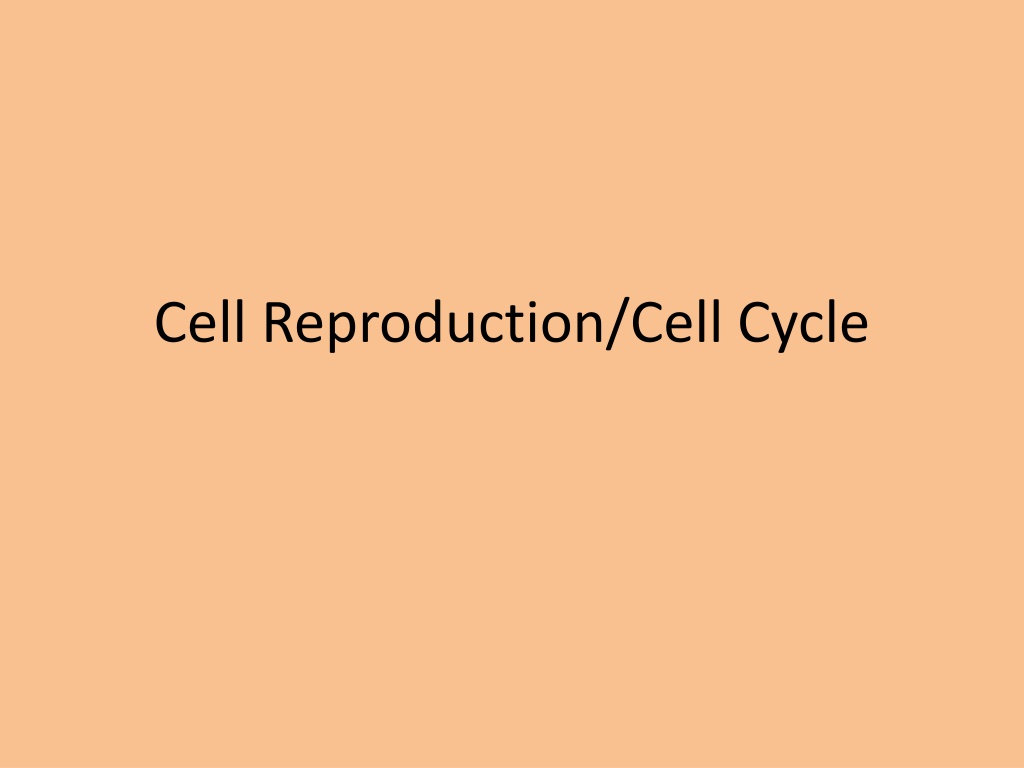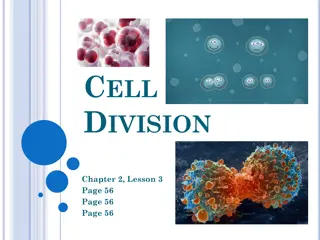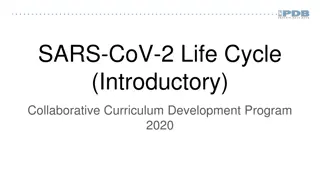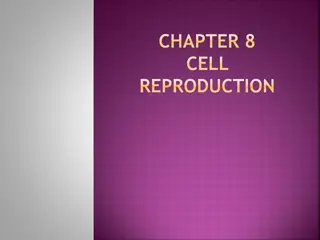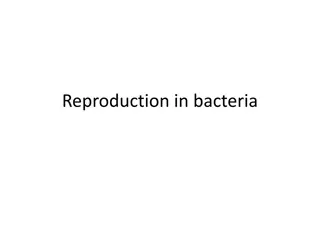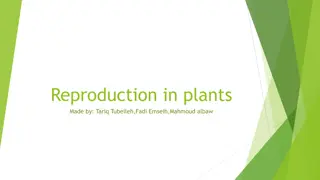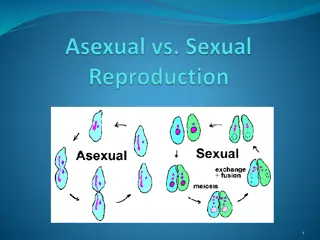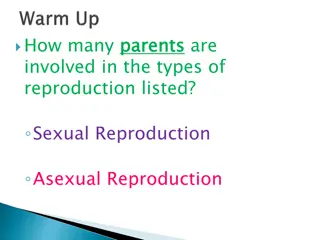Understanding Cell Reproduction and the Cell Cycle
Explore the process of cell reproduction, DNA structure, chromosomes, and the differences between prokaryotic and eukaryotic cell cycles. Learn about binary fission, mitosis, and cytokinesis in the context of cellular growth and division. Understand the significance of genes, DNA organization into chromosomes, and the intricate steps involved in the cell cycle of eukaryotic cells.
Download Presentation

Please find below an Image/Link to download the presentation.
The content on the website is provided AS IS for your information and personal use only. It may not be sold, licensed, or shared on other websites without obtaining consent from the author. Download presentation by click this link. If you encounter any issues during the download, it is possible that the publisher has removed the file from their server.
E N D
Presentation Transcript
DNA DNA deoxyribonucleic acid a long, thin molecule that contains info to make proteins DNA is organized into genes Genes is a segment of DNA that transmits information from parent to offspring Genes code for proteins Proteins determine traits
Chromosomes Chromosome tightly-coiled DNA. Chromatid a copy of a chromosome Called sister chromatids if two are attached Centromere protein that attaches two sister chromatids
Chromosomes The DNA in eukaryotic cells wraps around proteins called histones. They aid in shaping and maintaining the tight packing of DNA
I. Prokaryotic Cell Cycle A. Bacterial cells contain single, simple, circular strands of naked DNA. B. Binary Fission- asexual reproduction of prokaryotic cells. Steps to Binary Fission 1. COPY DNA 2. DNA SLIDES to opposite sides of the cell 3. Cell SPLITS Cell membrane pinches in creating 2 identical cells.
CELL CYCLE for Eukaryotic Cells Overview Life cycle of a cell that begins when a cell is formed and ends when it divides. G1 normal growth/ life of cell -majority of cell life. S DNA is copied (Synthesis of DNA) G2 Organelles are replicated -cell is prepared for nucleus to divide M Mitosis- nuclear division C Cytokinesis- cytoplasm divides (forms 2 new cells)
HW Questions Answer in complete sentences. In binary fission, how does the offspring s genes compare to the parent s genes? Explain. Using your knowledge of prokaryotic and eukaryotic cells, why do you think the eukaryotic cell cycle is longer/has more steps than the prokaryotic cell cycle?
II. Eukaryotic Cell Cycle A. Interphase normal growth phase of the cell. - the majority of the cell cycle is spent in interphase 1. G1 phase- growth of the cell immediately following cell division 2. S phase- DNA replication 3. G2phase- Replication of organelles, cell enlarges
Cells that dont reproduce dont have an S or G2phase. (ex. Red blood cells) Genetic material is in loose tangles of DNA and associated proteins (Histones) called Chromatin. Chromatin is invisible to most light microscopes.
B. Mitosis- the production of 2 new, identical nuclei. 1. Prophase (pairing) a. Chromatin coils to form thick, compact structures called Chromosomes. b. Sister chromatids are paired in a chromosome (two identical copies of DNA held together by a centromere) c. Nuclear membrane breaks down d. Centrosomes (bundles of microtubules) begin to move to opposite sides of the cell. -Spindle fibers extend from the centrioles (part of centrosome) across the cell
2. Metaphase (midline) a. Spindles attach to the centromeres of each chromosome. b. Chromosomes are pulled to the equator of the cell forming a line.
3. Anaphase (away) a. Centromeres are split and sister chromatids are pulled towards opposite sides of the cell. ** At this point each chromatid is now called a Chromosome.
4. Telophase (two nuclei) a. Identical chromosomes sets reach opposite sides of the cell. b. Spindle fibers break down. c. Two new nuclear membranes begin to form around the chromosome sets. d. Chromosomes begin to uncoil into chromatin. ** This ends mitosis, but not the cell cycle.
C. Cytokinesis- the splitting of the cytoplasm into two identical daughter cells. - In animal cells, the cell membrane is pinched in creating a cleavage furrow. - In plant cells, secretion vesicles form a cell plate between the chromosome sets splitting the cell membrane and cell wall. - Vesicles come from the Golgi
***After cytokinesis, each new cell immediately begins the G1 phase of Interphase.
Mitosis Rap https://www.youtube.com/watch?v=pOsAbTi 9tHw
Animal cell mitosis 4 2 6 1 3 5 7 9 11 10 12 8
III. Meiosis A. Homologous chromosomes- A. matching pairs of chromosomes that are the same size, shape and code for the same hereditary traits B. BUT may NOT be exactly alike.
Chromosome Types Sex chromosomes are chromosomes that determine the gender of an organism. XX female (mom gives X, dad gives X) XY male (mom gives X, dad gives Y) Autosomes All the other chromosomes other than the sex chromosomes.
Chromosomes Humans have two sex chromosomes One from mother One from father Human # Sex Chromosomes 1 pair 2 chromosomes
Human Chromosome Number Humans have two copies of each autosome. One set from mother One set from father Human # Autosomes 22 pair 44 chromosomes Total #= 23 pair 46 chromosomes
1. Diploid (2n) cells- contain a full set of homologous pairs - 1 set from mother - 1 set from father a. Diploid # is the total # of chromosomes in a normal body cell. ex. Human diploid # is 46
2. Haploid (n) cells- contain a half set of homologous pairs -(one copy from either mother or father) a. Haploid # is half of the diploid #. ex. Human haploid # is 23 b. Gametes (sex cells) are haploid. - male sperm (from father) - female egg (from mother) - fusion of egg and sperm produces a diploid (2n) cell called a zygote
How are gametes (the sperm and egg) made? Meiosis production of haploid gametes (sex cells)
Process of Meiosis Interphase occurs normally G1 S G2 Goal of meiosis is similar to mitosis now the goal is production of haploid cells (instead of diploid) There are two rounds of division in meiosis Split into Meiosis I and Meiosis II Phase names are the same (Pro-, Meta-, Ana-, Telo-)
B. Meiosis I 1. Prophase I a. Chromatin coils to form chromosomes. b. Nucleus disappears Special to Meiosis I: c. Homologous chromosomes pair up to form tetrads. d. The chromatid arms of the homologous pairs can become intermingled and exchange genetic material. (Crossing Over) - The random exchange of genes caused by crossing over creates chromosomes w/ a unique combination of genes. (Genetic Recombination)
2. Metaphase I a. Homologous pairs of chromosomes line up at the equator of the cell. (one on each side) -Homologous chromosomes are randomly lined up on midline. (Independent Assortment) b. Spindle fibers attach to the centromeres.
When gametes combine, offspring show variation due to independent assortment and crossing over
3. Anaphase I - Half of the chromosomes are pulled in one direction; other half pulled in opposite direction - Centromeres are not broken, sister chromatids remain attached - Chromosome number is reduced from diploid(2n) to haploid(n).
4. Telophase I/ Cytokinesis a. New nuclei may or may not form. b. Cell splits into two haploid cells (not genetically identical).
C. Meiosis II - Similar steps to mitosis, but w/ haploid cells. 1. Prophase II- sister chromatids are paired, centrioles migrate to opposite sides of cell 2. Metaphase II- Chromosomes line up on midline 3. Anaphase II- Sister chromatids are separated 4. Telophase II / Cytokinesis -form nuclear membranes around chromosomes -produces 4 genetically different, haploid gametes: -Males produce 4 functional sperm. -Females- only one cell becomes egg - other 3 are non-functional gametes (called polar bodies) http://highered.mcgraw- hill.com/sites/0072495855/student_view0/chapter28/animation__
Turn in homework from yesterday (if you haven t already) Answer the Check for Understanding questions on page 11 of the notes
Key points of Meiosis The process results in 4 daughter cells Daughter cells are haploid (n) Daughter cells have unique combinations of chromosomes
Meiosis creates gametes (sperm and eggs) Meiosis ensures variability in offspring Gametes combine to create a zygote which is diploid (2N) - process of sexual reproduction
Check for understanding 1. What phase directly follows telophase I? prophase II 2. How many cells are present at the end of meiosis I ? 2 3. A cell has a diploid number of 60, what is the organism's haploid number? 30 4. Meiosis forms what type of cells? gametes 5. In what phase do homologous chromosomes pair up and crossing-over can occur? prophase 1 6. In what phase do the CHROMATIDS separate? anaphase 2
Pg 180 7. Which of these pictures is metaphase I of MEIOSIS and which is metaphase of MITOSIS? Mitosis Meiosis
